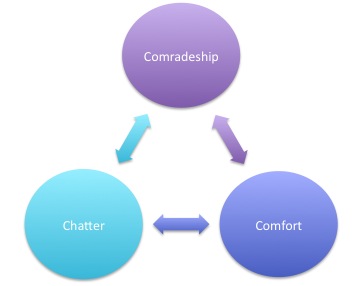 A couple of weeks ago, I noticed my friend Kim Wells was sporting a purple ribbon on her Twitter avatar.
A couple of weeks ago, I noticed my friend Kim Wells was sporting a purple ribbon on her Twitter avatar.
Ever-curious, I asked why.
Turns out October is, among many other things, Domestic Violence Awareness Month.
I say “among many other things,” because October can be associated with so many other colors. In the non-profit/cause marketing world, most notably pink, and thus breast cancer.
Image: Kurtis Garbutt via Flickr, Creative Commons
Kim, who runs the Corporate Alliance to End Partner Violence (CAEPV), asked what I thought was a valid question on her blog: where is all the purple?
Since I’ve been seeing a lot of cancer- and breast cancer-related tweets and posts through the month, I asked the same question.
Or, at least, I thought I did.
Orange?!
Ah, yes. Fall. Halloween. Etc.
Clearly, I worded the question wrong.
I should have asked, “Which cause-related color do you associate October with?”
Even so, while this poll can hardly be regarded as statistically accurate (especially since I messed the question up), pink still holds its own against orange.
Pink v. Purple
If we look at the data around breast cancer and domestic violence in the United States, here’s how just a few pieces stack up, and no, this is not a competition:
Breast cancer
– the chance of developing invasive breast cancer at some time in a woman’s life is a little less than 1 in 8 (12%)
– for men, the lifetime risk of getting breast cancer is about 1 in 1,000
– the chance that breast cancer will be responsible for a woman’s death is about 1 in 35 (about 3%).
All statistics from the American Cancer Society.
Domestic violence
– one in four women are victims of domestic violence at some point in their lives (from the CDC’s 2005 Behavioral Risk Factor Surveillance System survey as shared by the National Domestic Violence Hotline)
– one in nine men are victims of domestic violence at some point in their lives (also from the CDC’s 2005 Behavioral Risk Factor Surveillance System survey as shared by the National Domestic Violence Hotline)
– just over one-third of female homicide victims reported, and whose relationships with their offenders are known, are killed by an intimate partner (FBI’s Crime in the United States 2008 report).
There’s a lot of data out there and I am aware that these are just a few tiny pieces.
But it seems to me that domestic violence – against women and men – is at least as much of a concern as breast cancer is.
So where is all the purple?
First, you can’t get away from how pink, and by association breast cancer, rule October when it comes to causes and awareness.
Even if more and more people are starting to question the efficacy of these initiatives, it seems companies don’t want to be left out in the cold by not jumping on the pink bandwagon.
I’m calling this the comradeship factor.
Go pink = showing solidarity with those who’ve been touched by breast cancer. In other words, kinship.
Second, Kim hazards a guess in her blog post:
“A long time ago, no one talked about breast cancer – they kept it a secret, and somehow it was a ‘shame’ and was somehow the fault of the person who received the diagnosis.
“But fortunately that has changed, and we no longer blame breast cancer victims. We call them survivors. And we honor them for their amazing courage. And we should.
“Now – with domestic violence, we are not exactly there.
“We are uncomfortable with it because we are not really sure what ’causes’ it, whose ‘fault’ it is, what we should do about it, or how to even say something to someone. I don’t know all the reasons. I just know this – it is highly uncomfortable for us.”
So second, there’s the comfort factor.
Comradeship + comfort = chatter
If you put these two together, you get the chatter factor.
In other words, the more people realize they are not alone, the more they will feel comfortable talking about their own situation… and start doing so.
When companies realize their customers – existing or potential – want to talk about something, they jump on that bandwagon, and encourage people to talk about it even more. Or, these days, to click about it in some fashion or other.
So people do. And the people who weren’t talking before, realize that there are others like them out there.
And more organizations jump on board.
And more people talk.
And so on… becoming a cycle.
 By no means am I saying that this is all that goes into a cause’s ownership of a color or month to the point where it’s ubiquitous.
By no means am I saying that this is all that goes into a cause’s ownership of a color or month to the point where it’s ubiquitous.
And there are several other factors that go into creating an environment where we’re comfortable enough to talk about certain issues, as Herwin Icasiano pointed out when I was discussing this with him; government support (or lack thereof), the law of the land, and so on.
But I do think they are three core elements.
Back to purple
As Kim points out, we need to be comfortable enough to start talking about it.
Even in a country like the U.S., domestic violence is a very tough subject to bring up.
Off the top of my head, I can think of at least five women I know, some of whom I’ve known for decades, who’ve been victims.
But we don’t talk about it.
Because they don’t talk about it.
Maybe it’s too painful? Too frightening? Too tiring?
I also know at least three women who’ve suffered – and one died – from breast cancer.
But those who are left talk about it.
(Not) purple prose
My friend Liz Scherer, however, did confront her domestic violence ghosts and, in a moving post on her blog Flashfree, did just that: talk about it.
We need more survivors like Liz.
Winding down
So as October winds to a close please try, if you can, to spare a moment for purple or another color (and cause) amid your pink-mania.
I don’t think either breast cancer or domestic violence are going anywhere anytime soon, unfortunately.
But the tragedy and pervasiveness of the one doesn’t, and shouldn’t, detract from the tragedy and pervasiveness of the other, though far less-known.
And it’s time people started talking about it.
![[EVENT]: PR Hacks for Small Biz (online)](https://shonaliburke.com/wp-content/uploads/2021/06/FB-Ad-1200x800-01-01-01-Copy-500x383.jpeg)








[…] I’ve never bought into Komen’s “pink ribbon” deal, because its Goliath-like domination of the cause marketing world, not to mention the month of October, made me want to root for the […]
Hey Shonali……you have done an awesome thing by writing this and i must say good analysis….
I really got useful information.
http://www.eyehealthguide.net/color-blindness.html
Shonali, I love you even more for writing this post. :)
When I lived in Orlando, one of my pro bono clients was the local domestic violence shelter. I was so in awe of the women — and the courage it took for them to leave everything to start over, often only with the clothes on their backs. I became a co-facilitator for a weekly support group and I will forever be grateful for the lessons that I learned from those women. Being involved with that organization was one of the most amazing, inspiring experiences of my life.
To your point, domestic violence is still very much a taboo topic. (Actually, cancer, too, was taboo not all that long ago …) Too often, we think domestic violence is a “private matter” between two adults. For those not in abusive (physical, emotional or otherwise) relationships, we can’t understand why the victim doesn’t just leave. Unfortunately, it’s not that easy. And, staying in the relationship can be a safety measure, especially when the abuser threatens your children if you leave. It takes posts like yours to start discussions about domestic violence and a real commitment from people who refuse to turn a blind eye. Even if it’s uncomfortable, we have to do what we can to help those in abusive situations.
Kudos to you for using your blog to shine the light on domestic violence. <3
Heather
@prTini
Thank you, Heather!
While breast cancer hurts families, domestic violence destroys families creating a silent cycle which continues on for many generations.
First I didn’t realize October was also Domestic Violence Month. It’s unfortunate the cause has been so trumped by the pinks, which are also important.
I also agree completely about the reason why we don’t see more purple. Alaska has one of the highest rates of DV in the country. Recent reports show it has skyrocketed in past years which is VERY scary and sad. However, when one looks further at the numbers, it’s skyrocketing because more women are reporting domestic violence.
I find that hopeful as it will likely lead to more people talking about it, helping those who need help, and finding solutions to it.
Another AK piece of trivia…there’s a ski race for women to raise funds for abused women in crisis on Super Bowl Sunday…the day with the highest rate of abuse in the country! Sad but Alaskans have turned it into a fun, fund and awareness raiser. Thousands of women compete in fun costumes and celebration.
Only by talking and sharing will we increase awareness of this terrible problem. Thanks Shonali for increasing my awareness and Kim for the work you do each day.
The Alaska info is really interesting, thanks so much for sharing, Mary.
[…] This post was mentioned on Twitter by Shonali Burke, Pink Fans. Pink Fans said: Color Clash: Pink or Purple? | Waxing UnLyrical http://bit.ly/cBO7Hd […]